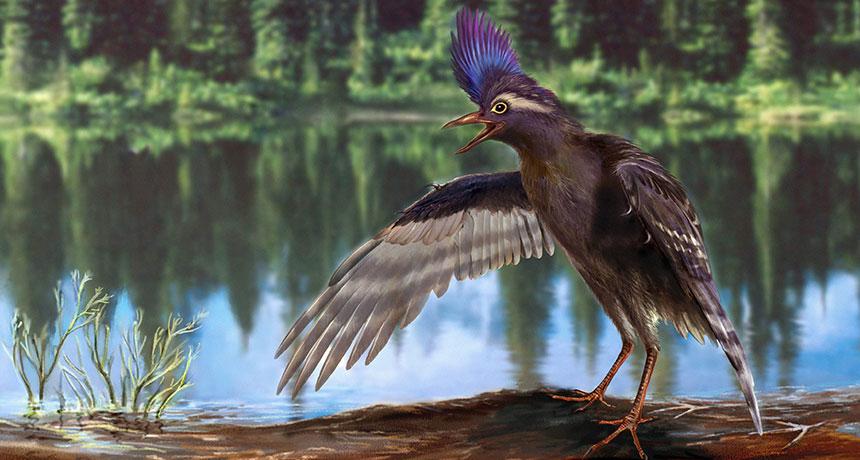Picture This: The real ‘early bird’
Its legs show signs it was equipped to wade through water

This drawing depicts the oldest known ancestral bird. It lived about 130 million years ago, during the time of the dinosaurs.
Zongda Zhang
By Meghan Rosen
Two partial skeletons set a new record for the oldest ancestral relative of today’s birds. Remains of these early birds turned up in northeastern China.
Fossil hunters discovered the bones of the hummingbird-sized creatures. Both were embedded in siltstone slabs. They come from a site that once may have been a lake. Stubby feathers covered the ancient birds’ bodies. The only bald spots were on the legs. Those feather-free patches suggest that these animals once waded through water. Or that’s what a research team led by paleontologist Min Wang of the Chinese Academy of Sciences now concludes. Wang’s team describes its new discovery May 5 in Nature Communications.
The ancient bird belonged to a species now being called Archaeornithura meemannae (AR-kee-orn-ih-THUUR-ah MEE-man-nay). It lived in what is known as the early Cretaceous Period, some 130.7 million years ago. This was at a time when dinosaurs still walked the Earth. It’s also about 6 million years before the last “earliest” known ancestor to modern birds.
The new species would not truly have been the “first” bird of its line. For instance, fossils show its feathers were “fairly advanced,” Wang’s team says. Species in this line also were “quite specialized at this point in their evolution,” the scientists say. Indeed, this bird appears to have evolved to live near shorelines.
So earlier, more primitive ancestors of today’s birds must have existed. Their fossils just have not yet turned up.
Power Words
(for more about Power Words, click here)
Cretaceous Period A geologic time period that included the end of the Age of Dinosaurs. It ran from roughly 145.5 million years ago until 65.5 million years ago.
dinosaur A term that means terrible lizard. These ancient reptiles lived from about 250 million years ago to roughly 65 million years ago. All descended from egg-laying reptiles known as archosaurs. Their descendants eventually split into two lines. They are distinguished by their hips. The lizard-hipped line became saurichians, such as two-footed theropods like T. rex and the lumbering four-footed Apatosaurus (once known as brontosaurus). A second line of so-called bird-hipped, or ornithischian dinosaurs, led to a widely differing group of animals that included the stegosaurs and duckbilled dinosaurs.
fossil Any preserved remains or traces of ancient life. There are many different types of fossils: The bones and other body parts of dinosaurs are called “body fossils.” Things like footprints are called “trace fossils.” Even specimens of dinosaur poop are fossils.
paleontologist A scientist who specializes in studying fossils, the remains of ancient organisms.
silt Very fine mineral particles or grains present in soil. They can be made of sand or other materials. When materials of this size make up most of the particles in soil, the composite is referred to as clay. Silt is formed by the erosion of rocks, and then usually deposited elsewhere by wind, water or glaciers.
siltstone A hard, durable type of rock that developed when siltlike particles of dirt or debris became compressed under pressure for eons.







